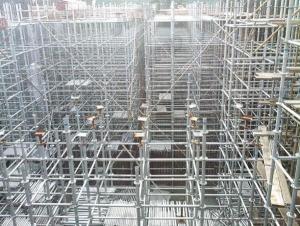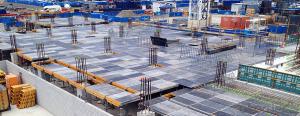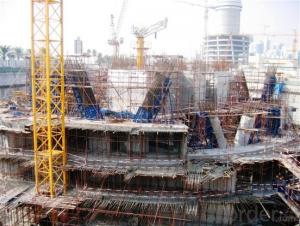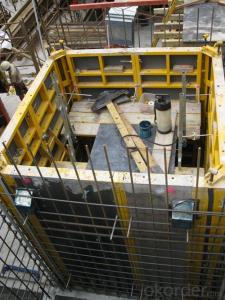The Advantaged Plastic Formworks in CNBM
- Loading Port:
- Tianjin
- Payment Terms:
- TT OR LC
- Min Order Qty:
- 1000 set
- Supply Capability:
- 50000 set/month
OKorder Service Pledge
OKorder Financial Service
You Might Also Like
Item specifice
Plastic Formwork Concrete Formwork Parts Of A Tubular Scaffolding Low Price
Developing with new technology materials, steel formworks is no longer a must in construction concrete process. More and more buildings are established with plastic formworks. And workers love this new formworks much more.

The advantages of plastic formworks:
1.First of all--light
Yes it is the first advantage of plastic formwork. It wins the great praise of both contractors and workers.
The biggest panel is 120×1500px,weights 10.5kg only. It can be lift and set up by one person easily, which means there is no need for cranes on site.Saves a lot of cost and time.
2.Easy set up
Different size of panels can firmly locked by simply turn the special handles to 90 degree. The Panels has rib on the back, which makes the system need not traditional wood blocks and nails. The panels have holes to fit tie rod, guarantee the strength of the whole system.
3.Modularity
Modular formworks composed by different size of panels,the main item is 120×1500px panel,which is used for the large area of walls and slabs. There are also small size of panels of multiply by 125px. The material of modular formwork is PC-ABS mixed with special glass fibers which enable panels to hold high pressures.
4.Strength
The handles are made by high strength Nilon, each panel locked by at least 4 handles, which makes the whole system strong enough to pour 1000px walls.
FAQ
We have organized several common questions for our clients, may help you sincerely:
1)How is the Packaging Details?
In bags or as the requirement ofcustomers.
2)How long can we receive the product after purchase?
Lead time is about 30days after getting the signed PI and deposit.
- Q:How does steel frame formwork affect the overall waterproofing of a structure?
- The overall waterproofing of a structure can be significantly affected by steel frame formwork. One of the main benefits of using steel frame formwork is its capacity to create a tight and secure enclosure for pouring concrete. This ensures that the concrete remains contained and does not leak or seep out during the curing process. Moreover, steel frame formwork is typically designed to be reused, allowing it to be utilized multiple times for different projects. This reusability aspect helps to maintain the integrity of the formwork system and prevents any potential problems with leakage or seepage. It also enables a more precise and accurate construction process, reducing the possibility of gaps or voids that could lead to water infiltration. Additionally, steel frame formwork is renowned for its strength and durability. This strength results in a sturdy and stable structure that can better withstand external forces and environmental conditions that may compromise the waterproofing system. By providing a solid foundation and support for the concrete, steel frame formwork ensures that the structure remains impervious to water and resistant to water-related damage. However, it is important to note that while steel frame formwork can greatly contribute to the overall waterproofing of a structure, it is not the sole determining factor. Other elements, such as proper design, installation, and the use of appropriate waterproofing materials, are also essential in achieving a watertight structure. In conclusion, steel frame formwork plays a crucial role in the overall waterproofing of a structure. Its ability to create a secure enclosure for pouring concrete, reusability, strength, and durability all contribute to the development of a watertight and resilient structure. However, it should be combined with other waterproofing measures to ensure the best possible outcome.
- Q:PKPM steel frame design inside the full design of the nodes inside the connection parameters are determined by the design institute to teach me
- Design of node connection parameters according to the actual situation, you project such as beam column connection, the connection plate thickness, column, beam connection, bolt size and form... And so on, according to the specific requirements of your project
- Q:Can steel frame formwork be used for both single-storey and multi-storey structures?
- Steel frame formwork is applicable for both single-storey and multi-storey structures. This versatile and durable system can easily adapt to various heights and configurations. Its exceptional strength and stability make it ideal for high-rise buildings and structures with multiple floors. Furthermore, steel frame formwork enables efficient and fast construction, resulting in reduced project timelines and costs. Consequently, it is widely utilized in both single-storey and multi-storey construction projects.
- Q:What are the key considerations for selecting the appropriate steel frame formwork accessories?
- Some key considerations for selecting the appropriate steel frame formwork accessories include the compatibility with the formwork system being used, the desired level of strength and durability, the ease of assembly and disassembly, the ability to accommodate different concrete pouring techniques, the availability of necessary safety features, and the overall cost-effectiveness of the accessories.
- Q:How does steel frame formwork affect the overall project timeline?
- The overall project timeline can be significantly affected by steel frame formwork. To begin with, compared to traditional timber formwork, steel frame formwork is generally faster to assemble and disassemble. This means that the formwork can be set up and removed more efficiently, resulting in reduced time for each concrete pour. Additionally, steel frame formwork allows for higher repetition rates, meaning that the same formwork can be easily reused for multiple pours. This eliminates the need for constant construction and dismantling of formwork, leading to further time savings. Moreover, steel frame formwork offers greater stability and durability compared to timber formwork. This stability allows for faster and more efficient concrete pouring, which in turn reduces the time required for each floor or section of the project. Furthermore, steel frame formwork can be pre-fabricated off-site, enabling concurrent construction activities. This means that while the formwork is being assembled on-site, other tasks such as earthworks or foundation construction can be carried out simultaneously, optimizing the project timeline. In conclusion, steel frame formwork brings various advantages that have a significant impact on the project timeline. These advantages include reduced assembly and disassembly time, higher repetition rates, stability for faster concrete pouring, and the ability to carry out concurrent construction activities. Ultimately, these benefits result in shorter construction schedules and timely project completion.
- Q:What are the common maintenance practices for steel frame formwork systems?
- To maintain steel frame formwork systems, it is important to regularly clean and inspect them, lubricate their moving parts, and repair or replace any damaged components. Cleaning is a crucial maintenance practice that involves removing any debris, concrete residue, or other materials that may have accumulated on the frames and panels. By regularly cleaning the formwork system, you can prevent corrosion and ensure its overall good condition. Inspection is another essential maintenance practice. It involves thoroughly examining the formwork system for any signs of damage or wear. This includes inspecting the frame, panels, connecting hardware, and other components for cracks, dents, or loose parts. It is important to conduct inspections before and after each use, as well as periodically during long projects. If any issues are detected during the inspection, they should be promptly addressed to prevent further damage. Lubrication is necessary for the smooth operation of the moving parts in a steel frame formwork system. This includes applying lubrication to hinges, locks, and other mechanisms to ensure their proper functioning. By lubricating these parts, you can reduce friction and wear, which in turn can extend the lifespan of the formwork system and enhance its performance. Repairing or replacing damaged components is crucial for maintaining the integrity of the steel frame formwork system. Any components that are cracked, bent, or otherwise damaged should be repaired or replaced as soon as possible. This may involve replacing worn-out panels, repairing damaged frames, or replacing faulty hardware. Regular inspections and prompt repair or replacement of damaged components can prevent accidents and help ensure that the formwork system remains safe and reliable. To summarize, common maintenance practices for steel frame formwork systems include regular cleaning and inspection, lubrication of moving parts, and repair or replacement of damaged components. By following these practices, you can ensure the longevity and proper functioning of the formwork system, promoting safety and efficiency on construction sites.
- Q:Can steel frame formwork be used for both reinforced and non-reinforced concrete elements?
- Yes, steel frame formwork can be used for both reinforced and non-reinforced concrete elements. The steel frame provides the necessary support and stability for the formwork, regardless of whether reinforcement is required or not.
- Q:What maintenance is required for steel frame formwork?
- Maintenance for steel frame formwork typically includes regular cleaning, inspection, and repair as needed. Here are some specific maintenance tasks for steel frame formwork: 1. Cleaning: It is important to clean the steel frame formwork after each use to remove any concrete residue or debris. This can be done using water, soap, and a brush or pressure washer. Regular cleaning helps prevent corrosion and ensures the longevity of the formwork. 2. Inspection: Regular inspections are necessary to identify any signs of damage or wear and tear. Inspect the frame for cracks, dents, bent or loose components, and damaged connections. Pay special attention to areas that are exposed to high stress or pressure during use. 3. Repair: If any damages or defects are found during the inspection, immediate repair is essential. Repair or replace any damaged components to maintain the structural integrity of the formwork. This may involve welding, grinding, or replacing parts as necessary. 4. Lubrication: Lubricating movable parts of the steel frame formwork, such as hinges, bolts, and sliding mechanisms, helps prevent friction and ensures smooth operation. Use appropriate lubricants recommended by the manufacturer to minimize wear and prolong the life of the formwork. 5. Storage: Proper storage is vital to prevent damage and corrosion. Store the steel frame formwork in a clean and dry area, away from direct sunlight, moisture, and harsh weather conditions. Use protective covers or coatings to shield the formwork from corrosion during storage. 6. Training: It is important to provide proper training to the personnel handling the steel frame formwork. Educate them about the correct usage, handling, and maintenance procedures to ensure optimal performance and safety. By following these maintenance practices, steel frame formwork can be kept in good condition, resulting in improved safety, efficiency, and durability during construction projects.
- Q:Can steel frame formwork be used for decorative concrete finishes?
- Yes, steel frame formwork can be used for decorative concrete finishes. The sturdy construction of steel frame formwork allows for precise shaping and molding of concrete, which is essential for achieving intricate decorative designs. Additionally, steel frame formwork provides excellent support and stability, ensuring that the finished concrete surface remains smooth and free from defects.
- Q:Can steel frame formwork be adjusted to accommodate different dimensions?
- Steel frame formwork is capable of being adjusted to accommodate a range of dimensions. One of the benefits of utilizing steel frame formwork is its ability to be flexible and adaptable to different construction projects. The steel frames can be easily altered by the addition or removal of panels, adjustments to the height, or changes to the configuration, all of which can be tailored to suit the various dimensions and shapes of concrete structures. This adjustability characteristic allows for the efficient and effective utilization of the formwork system, resulting in time and cost savings during the construction process. Furthermore, the strength and durability of steel ensure stability and structural integrity, making it a dependable choice for accommodating various dimensions in formwork applications.
1. Manufacturer Overview |
|
|---|---|
| Location | |
| Year Established | |
| Annual Output Value | |
| Main Markets | |
| Company Certifications | |
2. Manufacturer Certificates |
|
|---|---|
| a) Certification Name | |
| Range | |
| Reference | |
| Validity Period | |
3. Manufacturer Capability |
|
|---|---|
| a)Trade Capacity | |
| Nearest Port | |
| Export Percentage | |
| No.of Employees in Trade Department | |
| Language Spoken: | |
| b)Factory Information | |
| Factory Size: | |
| No. of Production Lines | |
| Contract Manufacturing | |
| Product Price Range | |
Send your message to us
The Advantaged Plastic Formworks in CNBM
- Loading Port:
- Tianjin
- Payment Terms:
- TT OR LC
- Min Order Qty:
- 1000 set
- Supply Capability:
- 50000 set/month
OKorder Service Pledge
OKorder Financial Service
Similar products
New products
Hot products


























